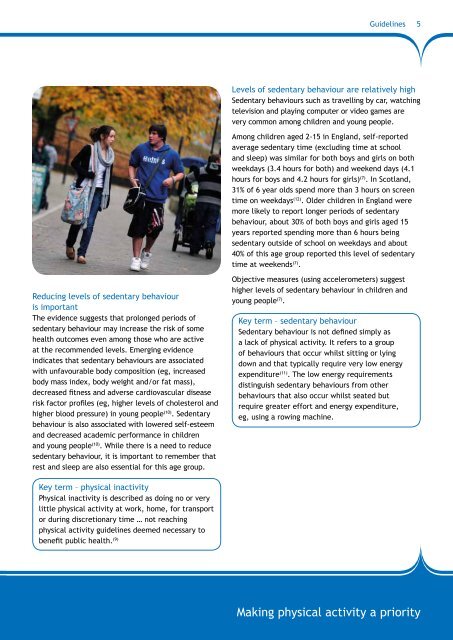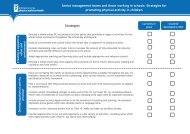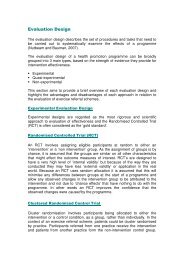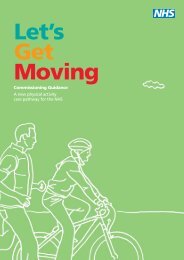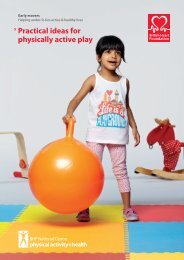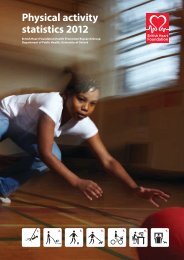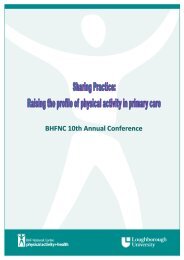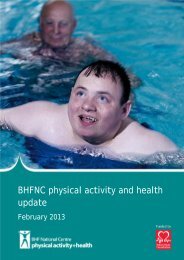Interpreting the UK physical activity guidelines for children and ...
Interpreting the UK physical activity guidelines for children and ...
Interpreting the UK physical activity guidelines for children and ...
Create successful ePaper yourself
Turn your PDF publications into a flip-book with our unique Google optimized e-Paper software.
Guidelines<br />
5<br />
Levels of sedentary behaviour are relatively high<br />
Sedentary behaviours such as travelling by car, watching<br />
television <strong>and</strong> playing computer or video games are<br />
very common among <strong>children</strong> <strong>and</strong> young people.<br />
Among <strong>children</strong> aged 2-15 in Engl<strong>and</strong>, self-reported<br />
average sedentary time (excluding time at school<br />
<strong>and</strong> sleep) was similar <strong>for</strong> both boys <strong>and</strong> girls on both<br />
weekdays (3.4 hours <strong>for</strong> both) <strong>and</strong> weekend days (4.1<br />
hours <strong>for</strong> boys <strong>and</strong> 4.2 hours <strong>for</strong> girls) (7) . In Scotl<strong>and</strong>,<br />
31% of 6 year olds spend more than 3 hours on screen<br />
time on weekdays (12) . Older <strong>children</strong> in Engl<strong>and</strong> were<br />
more likely to report longer periods of sedentary<br />
behaviour, about 30% of both boys <strong>and</strong> girls aged 15<br />
years reported spending more than 6 hours being<br />
sedentary outside of school on weekdays <strong>and</strong> about<br />
40% of this age group reported this level of sedentary<br />
time at weekends (7) .<br />
Reducing levels of sedentary behaviour<br />
is important<br />
The evidence suggests that prolonged periods of<br />
sedentary behaviour may increase <strong>the</strong> risk of some<br />
health outcomes even among those who are active<br />
at <strong>the</strong> recommended levels. Emerging evidence<br />
indicates that sedentary behaviours are associated<br />
with unfavourable body composition (eg, increased<br />
body mass index, body weight <strong>and</strong>/or fat mass),<br />
decreased fitness <strong>and</strong> adverse cardiovascular disease<br />
risk factor profiles (eg, higher levels of cholesterol <strong>and</strong><br />
higher blood pressure) in young people (10) . Sedentary<br />
behaviour is also associated with lowered self-esteem<br />
<strong>and</strong> decreased academic per<strong>for</strong>mance in <strong>children</strong><br />
<strong>and</strong> young people (10) . While <strong>the</strong>re is a need to reduce<br />
sedentary behaviour, it is important to remember that<br />
rest <strong>and</strong> sleep are also essential <strong>for</strong> this age group.<br />
Objective measures (using accelerometers) suggest<br />
higher levels of sedentary behaviour in <strong>children</strong> <strong>and</strong><br />
young people (7) .<br />
Key term – sedentary behaviour<br />
Sedentary behaviour is not defined simply as<br />
a lack of <strong>physical</strong> <strong>activity</strong>. It refers to a group<br />
of behaviours that occur whilst sitting or lying<br />
down <strong>and</strong> that typically require very low energy<br />
expenditure (11) . The low energy requirements<br />
distinguish sedentary behaviours from o<strong>the</strong>r<br />
behaviours that also occur whilst seated but<br />
require greater ef<strong>for</strong>t <strong>and</strong> energy expenditure,<br />
eg, using a rowing machine.<br />
Key term – <strong>physical</strong> in<strong>activity</strong><br />
Physical in<strong>activity</strong> is described as doing no or very<br />
little <strong>physical</strong> <strong>activity</strong> at work, home, <strong>for</strong> transport<br />
or during discretionary time … not reaching<br />
<strong>physical</strong> <strong>activity</strong> <strong>guidelines</strong> deemed necessary to<br />
benefit public health. (9)<br />
Making <strong>physical</strong> <strong>activity</strong> a priority


